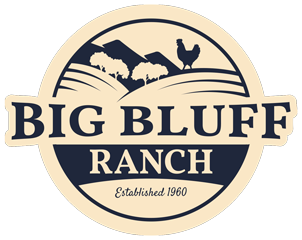Cover Crops - all you need to know
We’re cover cropping experts at Big Bluff Ranch.
Not familiar with cover cropping? Few outside of the farming community are. In short, cover cropping is a sustainable and environmentally friendly approach to agriculture. This comprehensive guide will explore the various aspects of cover cropping, its benefits, and its implementation in farming systems. By understanding the basics of cover cropping and its advantages, we can work towards a more sustainable future for agriculture and the environment.
How does all this relate to chicken farming?
To us at Big Bluff Ranch, it’s all a part of the same picture: Plants grown used cover cropping methods, chickens raised sustainably – all friendly for the environment and, of course, your health.
What is a Cover Crop?
A cover crop is a plant species grown primarily to improve soil health, prevent soil erosion, and increase overall land fertility. They are not grown for direct consumption but instead serve to support and enhance the growth of cash crops. Cover crops feed the soil microbiome, improve water infiltration, increase mineral availability, and reduce the need for synthetic fertilizers. As a result, they contribute to a healthier ecosystem, promote crop growth, and provide food for animals.
Why Use Cover Crops?
Cover crops help us capture free energy from sunlight through chlorophyll in plants. By growing cover crops when cash crops are not in season, we maximize the photosynthetic capacity of the land, ultimately leading to better cash crop growth. Moreover, cover crops are an essential component of sustainable agriculture, supporting both the environment and the farmers who rely on it.
Basics of Cover Cropping
The core principles of cover cropping include:
No bare soil: Keeping the soil covered with plants prevents erosion and supports soil health.
No monocrops: Diverse plant species promote biodiversity and provide a range of benefits.
Always include animals: Integrating livestock into the system supports soil fertility and pest management.
Common cover crop plants can be divided into two categories:
Legumes: Nitrogen-fixing plants such as alfalfa, peas, and beans that help avoid synthetic fertilizers.
Non-Legumes: Grasses that provide ground cover and support soil health.
Cover crops can also be grown in mixtures or "cocktails" to maximize their benefits.
Basic Techniques of Cover Cropping
There are several methods to implement cover cropping, including:
No-till farming: This approach minimizes soil disturbance and retains soil structure.
Controlled grazing: Livestock are used to graze cover crops in a managed way, supporting soil health and pest control.
Crop rotations: Alternating cover crops with cash crops diversifies the land and provides different benefits.
Benefits of Planting Cover Crops
Cover crops offer a wide range of benefits, such as:
Soil erosion prevention
Soil fertility management
Soil quality improvement
Water management
Weed management
Disease management
Pest management
Biodiversity and wildlife support
Considerations for Deciding What to Grow
When deciding which cover crop to grow, consider factors like your land's specific needs, the plants that can address those needs, and the management of the crop. It is essential to balance complexity with practicality, as your decisions will significantly impact the success of your cover cropping efforts.
How are Cover Crops Used in Farming Systems?
Innovative farmers use cover crops to improve profitability, lower input costs, increase cash crop diversity, and create a sustainable and low-stress lifestyle. By integrating cover crops into livestock operations like pasture poultry and rangeland management, farmers can improve land fertility, support diverse plant growth, and feed more animals on the same acreage.
The Future of Cover Cropping
Government programs like the California Healthy Soils Initiative and the USDA's EQIP and CSP are supporting cover cropping efforts. Additionally, private companies are investing in carbon credits and sustainable agriculture initiatives. By continuing to explore new techniques and strategies, the future of cover cropping looks promising for sustainable agriculture and environmental conservation.
